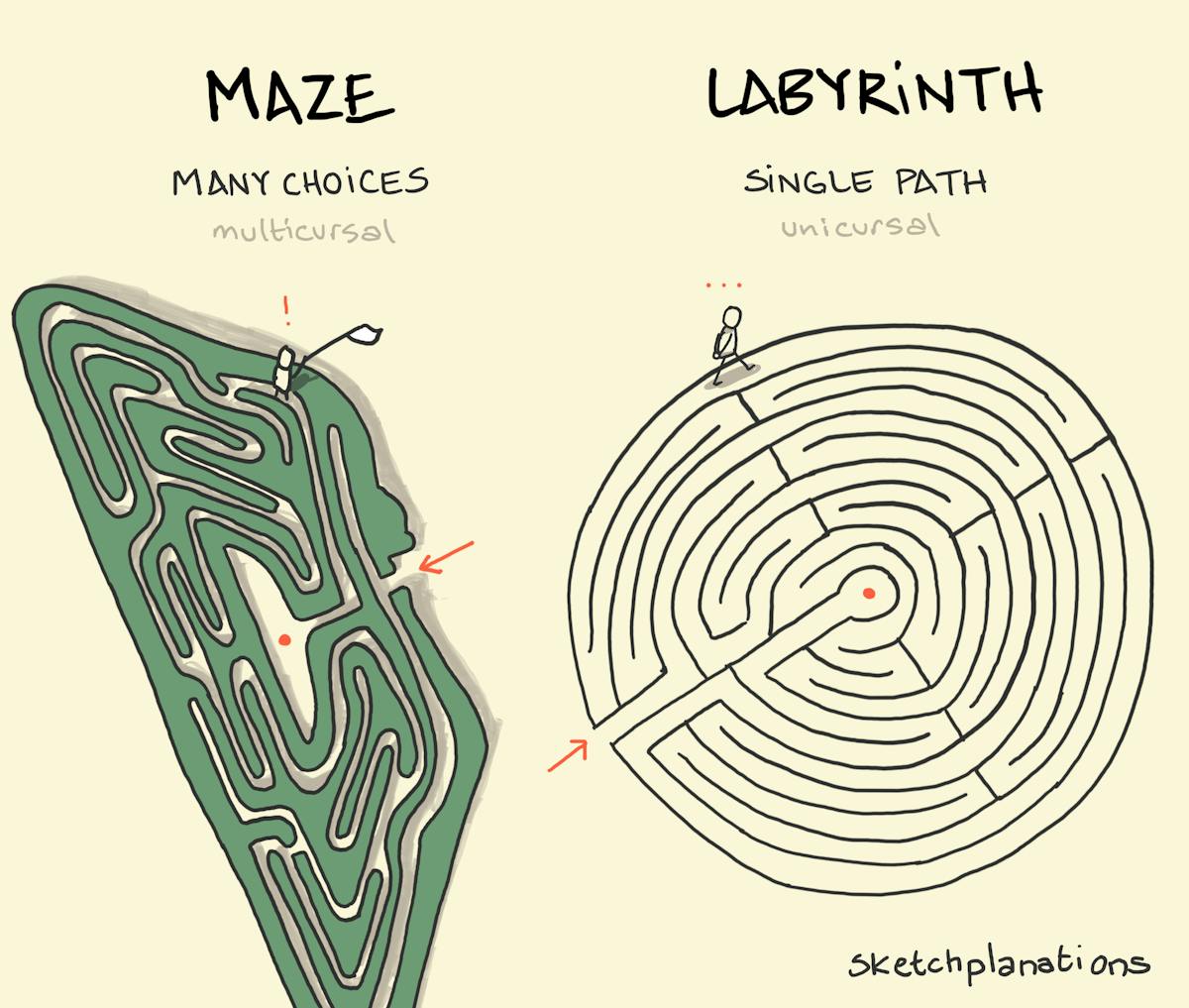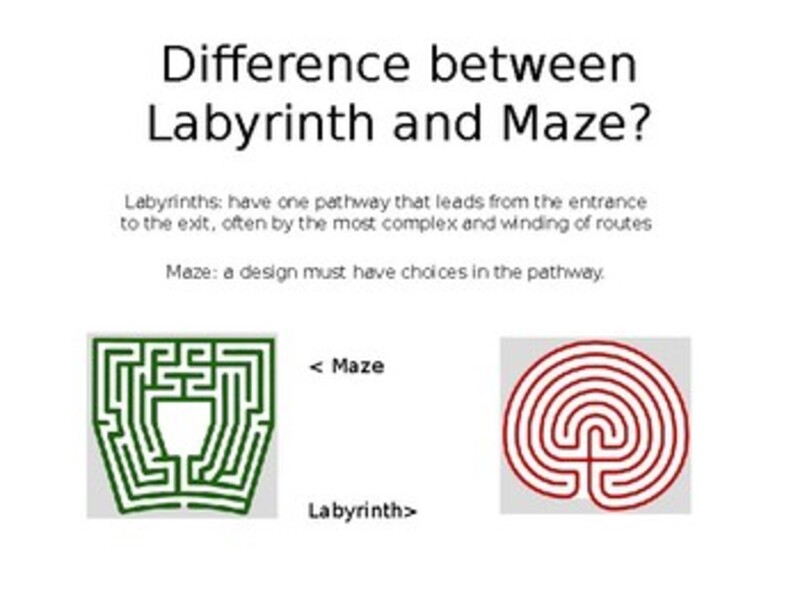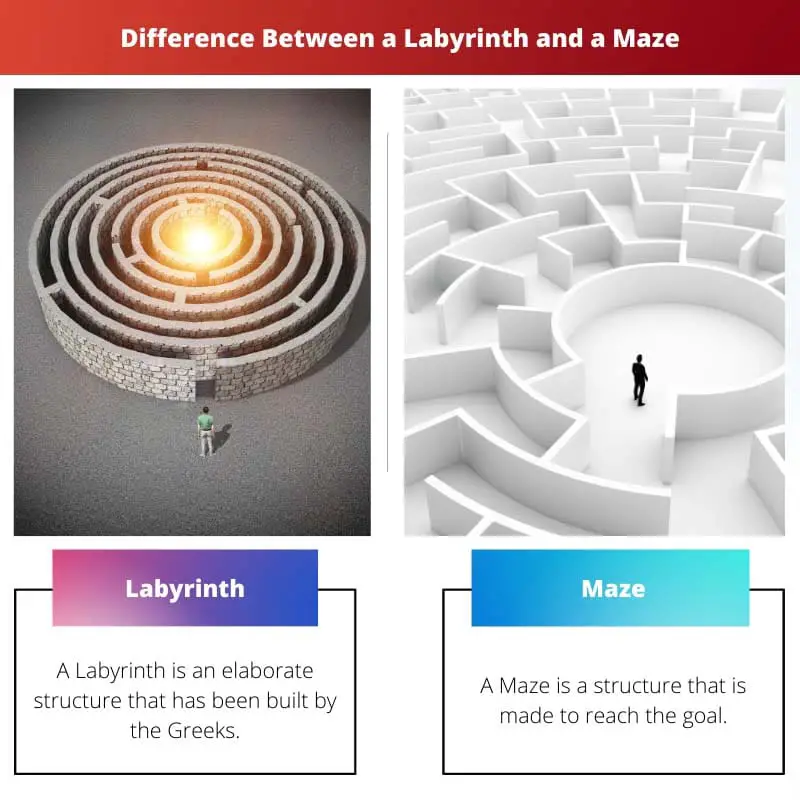
Labyrinths and mazes Sketchplanations
Tilted Maze - A type of conditional maze where you imagine yourself tilting the maze (pretend you are a marble inside the maze), and then moving in the direction chosen until you reach a wall. Each tilt takes you to a new wall until you reach the exit. You can play a this maze type, designed by Andrea Gilbert, here.

Un laberinto y un laberinto 2020 PALABRAS
Labyrinth and maze are both intricate structures designed to challenge and confuse individuals navigating through them. However, there are some key differences between the two. A labyrinth typically consists of a single, winding path that leads to a central point and then back out again, symbolizing a journey of self-discovery or spiritual.

The 10 Most Amazing Mazes and Labyrinths in the World
Differences between Labyrinth and Maze. There are several differences between a maze and a labyrinth, including: Complexity: Mazes are designed to be complex and challenging, with many dead ends and false paths. Labyrinths, on the other hand, have a single, winding path that leads to the center and back out again.

The puzzling difference between mazes and labyrinths Financial Times
The distinction between a labyrinth and a maze lies in the fact that a labyrinth typically consists of a single winding path leading to a central goal, while a maze is a complex and often confusing network of branching paths with multiple choices, dead ends, and possibly multiple entrances and exits. Learn the difference here.

Maze vs Labyrinth — Let’s Compare And See The Difference! STEM Geek
Difference between a Labyrinth and a Maze in tabular form. Labyrinths are complex puzzles with a single winding path ending at the centre. Mazes are designed to be a puzzle that challenges the navigating person to find the end. It has a single winding path that leads to the centre.

When Navigating The EL Labyrinth, Routines Make All The Difference Organized Binder
It may be long but there is only one path (unicursal). A maze is a tour puzzle and can be designed with various levels of difficulty and complexity. A labyrinth has only one entrance and that is also the exit. There is just one path from the entrance to the center. A maze may have different entry and exit points.

WHAT IS LABYRINTH — Red Doors Studio
Which begs the question: what is the difference between a maze and a labyrinth? Although considered synonymous by some, it is generally accepted that a labyrinth contains only one path, often.
What are labyrinths and mazes? What are their differences and how are they built? Quora
The main difference between a maze and a labyrinth is that a maze has many different branching paths that can be taken, whereas a labyrinth has only one possible route. A maze is a puzzle to be solved, whereas a labyrinth can be viewed as a spiritual or meditative tool. In this article, I'll go into much more detail about the differences.

Is There a Difference Between a Maze and a Labyrinth ? — Do you maze?
is that labyrinth is a maze, especially underground or covered while maze is a labyrinth; a puzzle consisting of a complicated network of paths or passages, the aim of which is to find one's way. As verbs the difference between labyrinth and maze is that labyrinth is to enclose in a labyrinth, or as though in a labyrinth while maze is to amaze.

Premium Vector Mazes or labyrinths diagrams set
The difference between a labyrinth and a maze is that Labyrinth is a type of Maze. A maze is a large structure that consists of different types of pathways. In Labyrinth, there is only one entry and exit point. While in a maze, there can be multiple entries and exit points. Paths are unicursal in a labyrinth. Paths are multicursal in a maze.

The difference between a maze and a labirytnth. from Roxana Adams's board Adventures in
The terms Maze and Labyrinth are often used interchangeably in modern contexts, leading to some confusion. However, those in the know understand the distinguishing features: a Maze is a test of decision-making and memory, while a Labyrinth is a contemplative, unambiguous journey. Tayyaba Rehman. Sep 22, 2023. 9.

What is the name for a labyrinth with no known exits? AnandTech Forums Technology, Hardware
There's a crucial, and wonderful, distinction between mazes and labyrinths. A maze is a multi-branching, complex structure with twists, turns, choices, dead-ends and treasure or Triwizard cups in the centre. It's confusing, daunting, exciting, fun, challenging, maybe deadly. A maze heightens awareness, concentration, and your heart rate. A labyrinth has a single path. One long, twisting, but.
Susan Carpenter's 1st and 2nd Grade Classroom Daedalus and the Labyrinth
The difference between mazes and labyrinths is that labyrinths have a single continuous path which leads to the centre, and as long as you keep going forward, you will get there eventually. Mazes have multiple paths which branch off and will not necessarily lead to the centre. In a maze, you can get lost, but in a labyrinth, you can't.

a Labyrinth vs a Maze Difference and Comparison
LABYRINTHS. Multiple pathways; branches off from main course in several places. Traditionally made of walls or tall hedges. Meant to confuse, perplex, and sometimes instill panic and fear. One single pathway leading to the center, usually in a circum-ambulatory fashion. Traditionally made from small hedges, stones, or lines drawn on the ground.

Building your labyrinth Maze design, Reality creation, Puzzle design
In essence, while a maze requires problem-solving and can lead to confusion, a labyrinth is about meditation and reflection. Sumera Saeed. Oct 18, 2023. 7. Throughout history, the labyrinth has often been a spiritual tool, whereas the maze has been a form of entertainment or puzzle. Aimie Carlson.
The puzzling difference between mazes and labyrinths
The largest and most widely cited difference between a labyrinth and maze is that one unicursal and one is multicursal. This refers to the amount of options in the paths you can take. A labyrinth is a maze with no branches; the participant is required to follow the only path available. This is reason a labyrinth is considered unicursal.